
2016年3月31日,在加利福尼亞州的奧克蘭,工會的工人舉著標語游行,他們希望加州的最低時薪在2022年之前提高到15美元。米爾頓·莫斯科維茨相信,美國的最佳職場能夠給其他公司帶來重要的經驗。在他的啟發下,美國職場辦公室成立,并計劃根據公司最佳的職場實踐發布一份評分榜單。圖片來源:Justin Sullivan—Getty Images
|
1984年,米爾頓·莫斯科維茨與羅伯特·列弗寧首次出版了作品《美國最適合工作的100家公司》(The 100 Best Companies to Work for in America)。直至今年3月5日逝世,莫斯科維茨一直相信更好的職場會造就更好的公司。他的創舉是把針對數百萬個員工的調查數據轉化為職場創新的故事。這些故事實在引人入勝,以至于管理者開始紛紛關注這一榜單,并力爭在榜單上占有一席之地。 莫斯科維茨堅信,美國的最佳職場能夠給其他公司帶來重要的經驗。他的信念幫助促成了一個新的聯邦機構誕生。推廣最佳職場實踐給公司帶來的幫助,似乎就像農業推廣服務給農業帶來的幫助一樣。為了應對愛爾蘭大饑荒,Pioneered in Ireland應運而生,推廣員組織農民交換信息和技能以促進生產。在克林頓執政初期,我想知道政府能否采用類似的做法改善美國職場? 勞工部長提名人羅伯特·賴克相信我們可以做到。他認為,勞工部不僅應該收集關鍵經濟數據、執行辦公場所標準、為培訓項目籌措資金,還應該分析和推廣那些給小時工提供培訓和激勵的優秀職場。從1993年到1996年,勞工部建立了美國職場辦公室(Office of the American Workplace)。它和莫斯科維茨的理念一致,相信偉大的公司與員工心連心。我幫助勸說賴克成立了這一機構,并被任命為它的主任。 賴克提出了挑戰,要求辦公室建立公開的評判標準,根據各公司的職場實踐給它們打分。他希望華爾街獎勵那些支持培訓、多樣化、薪酬平等,反對裁員、外包和關閉工廠的公司。 我喜歡這個公開評判標準的想法(目前仍然如此),不過我們只是一家很小的機構,而當時美國有大約600萬個辦公場所。此外,我也不確定職場實踐和公司業績之間的關聯是否足夠明顯到讓華爾街給予關注。 商業的成功無法用單一因素來解釋。產品和服務創新、成本競爭力、明智的領導——以及時間和運氣——都會影響公司業績。例如,直到20世紀90年代早期,IBM還在培訓員工上大量投入,堅持通過損耗而不是裁員來縮減員工規模。公司還把女性和少數族裔提拔至管理層。但是他們在個人電腦的革新上出現了重大的管理失誤,遭遇了慘痛的虧損。相反,微軟(Microsoft)在1993年至1994年間增長了約20%,但他們在改善職場上沒有任何明顯的創舉。我擔心,這樣一份推薦IBM而不是微軟的職場質量指標在券商那里會顯得無足輕重。 然而,賴克沒有那么容易被勸阻。在向他推銷了有關工作場所非常重要的想法之后,我就沒有了推諉的立場。所以我建議找那些我們認為可能會用到這種職場指數的首席執行官和華爾街交易員測試一番。賴克推薦了貝爾斯登(Bear Stearns)的首席執行官艾倫·格林伯格和強生公司(Johnson & Johnson)的首席執行官詹姆斯·伯克。我推薦了投資者沃倫·巴非特和黑石集團(Blackstone Group)的董事長彼得·彼得森。 最后,我們把上述這些和另外一些美國資本界的巨頭請到了一起,看看他們對這一職場質量指數有何評價。賴克和我的腦海中滿是莫斯科維茨的想法,我們解釋了這個指數的機制、數據的來源,以及希望投資者如何利用這一信息。隨后,每位領袖都耐心地解釋我們的想法為什么不可行。理由之一是華爾街交易的是公司,而不是職場。強大而充滿信任的職場文化和公司業績之間存在一定聯系,但不能完全確保最終業績的強勢。畢竟,杰克·韋爾奇治下的通用電氣(General Electric)就是通過裁員和生產外包擴大了利潤。 即使華爾街對這一信息不買賬,但認可那些美國最具創新力的職場仍然意義十足。我聯系了莫斯科維茨,得到了他的建議。勞工部能否設立一個類似于馬爾科姆·鮑德里奇國家質量獎(Malcolm Baldrige National Quality Award)的獎項?他擔心政府的獎項太容易被政治化。那么,像《財富》雜志對美國的大公司那樣,頒布一份最佳職場的年度榜單呢?讓一家商業雜志公布他的榜單,相當于結合了評分和頒獎的意味。莫斯科維茨采納了這一想法。1998年,《財富》雜志開始根據他的調查與分析,發布一年一度的“最佳職場100強”榜單。 一些公司繼續質疑登上這份“最佳職場”榜單的商業價值。然而,2010年《金融經濟學刊》(Journal of Financial Economics)上的一份研究根據莫斯科維茨遴選的公司建立了一個投資組合,并針對公司特征、領域和離群值等因素進行了統計控制。作者得出結論稱,“最佳職場”投資組合的表現顯著優于行業基準水平,因為股市沒有充分評判盡職盡責的員工等無形資產。事實證明,莫斯科維茨一直是對的。(財富中文網) 作者馬丁·曼利曾經擔任美國勞工部部長助理,是兩家硅谷科技公司的聯合創始人和首席執行官。他的新著《更好的交易:調動雇主和員工來拯救美國中產階級》(A Better Bargain: Organizing Employers and Workers to Save America’s Middle Class)即將出版。 譯者:嚴匡正 |
Milton Moskowitz first published The 100 Best Companies to Work for in America with Robert Levering in 1984. Until his death on March 5, Moskowitz believed that better workplaces produce better companies. His genius was to transform data from surveys of millions of workers into stories about workplace innovation so compelling that managers began to take notice and compete for a place on his list. Moskowitz was convinced that America’s best workplaces had important lessons to teach the rest. His conviction helped inspire the creation of a new federal agency. Promoting workplace best practices seemed like it could offer benefits to companies in the way agricultural extension services did for agriculture. Pioneered in Ireland in response to the potato famine, extension agents organized the exchange of information and skill between farmers to promote production. In the early days of the Clinton administration, I wondered whether the government could do something similar for U.S. workplaces? Labor Secretary nominee Robert Reich believed we could. He thought that the Labor Department should not only collect critical economic data, enforce workplace standards, and fund training programs, but that it should also analyze and promote workplaces that trained and empowered hourly workers. From 1993 to 1996, the Labor Department operated the Office of the American Workplace which was, like Moskowitz, devoted to the notion that great companies are highly committed to their workers. I helped persuade Reich to create the agency and was appointed to lead it. Reich challenged the agency to create a public scorecard that graded companies based on their workplace practices. He hoped that Wall Street might reward companies that embraced training, diversity, and pay equity and resisted layoffs, outsourcing, or plant closures. I loved the idea of a public scorecard (and still do) but we were a small agency and, at the time, the U.S. had some 6 million workplaces. Moreover, I doubted that the connection between workplace practices and corporate performance was robust enough for Wall Street to care. There are no single-factor explanations of business success. Product and service innovation, cost competitiveness, and smart leadership—as well as timing and luck—all affect business performance. Until the early 1990s, for instance, IBM invested heavily in training its employees and remained committed to shrinking its workforce through attrition, not layoffs. They promoted women and minorities into leadership. But the company had horribly mismanaged the PC revolution and was experiencing major losses. Microsoft, in contrast, had grown around 20% from 1993 to 1994 without any prominent workplace initiatives. I worried that a workplace quality index that promoted IBM but not Microsoft would carry little weight with securities traders. Reich, however, was not easily dissuaded. And having sold him on the idea that workplaces mattered, I was in no position to equivocate. So I suggested that we test the workplace index with the CEOs and Wall Street traders we thought might use it. Reich proposed Alan Greenberg, CEO of Bear Stearns, and James Burke, the CEO of Johnson & Johnson. I suggested investor Warren Buffett and Peter Peterson, chairman of Blackstone Group. Eventually, we brought together these and several other titans of American capitalism to tell us whether they would value an index of workplace quality. With Moskowitz very much on our minds, Reich and I described how it might work, where the data would come from, and how we hoped investors might use the information. Afterwards, each leader patiently explained why our idea wouldn’t work. One example offered was that Wall Street traded companies, not workplaces. The link between a strong, high-trust workplace culture and corporate performance was indicative—but not fully predictive—of strong business results. After all, companies like General Electric under Jack Welch had increased their profits by laying off staff and outsourcing manufacturing. Even if Wall Street wouldn’t trade on the information, it still made sense to recognize America’s most innovative workplaces. I contacted Moskowitz to get his advice. Should the Labor Department create a prize like the Malcolm Baldrige National Quality Award? He worried that government prizes were too easily politicized. What about issuing an annual list of best workplaces like Fortune did for America’s largest companies? Having a business magazine publish his list would combine the best elements of a scorecard and a prize. Moskowitz pursued the idea and, in 1998, Fortune began publishing its annual “100 Best Places to Work” list based on his surveys and analysis. Some companies continued to doubt that membership in the “Best Places to Work” list had business value. In 2010, however, a study in the Journal of Financial Economics created a portfolio of his companies and applied statistical controls for factors such as firm characteristics, sector, and outliers. They concluded that the “Best Places to Work” portfolio significantly outperformed industry benchmarks because the stock market does not fully value intangible assets like committed workers. Moskowitz, it turns out, had been right. Martin Manley served as Assistant U.S. Secretary of Labor and subsequently as the co-founder and CEO of two Silicon Valley technology companies. He is the author of the forthcoming book: A Better Bargain: Organizing Employers and Workers to Save America’s Middle Class. |






